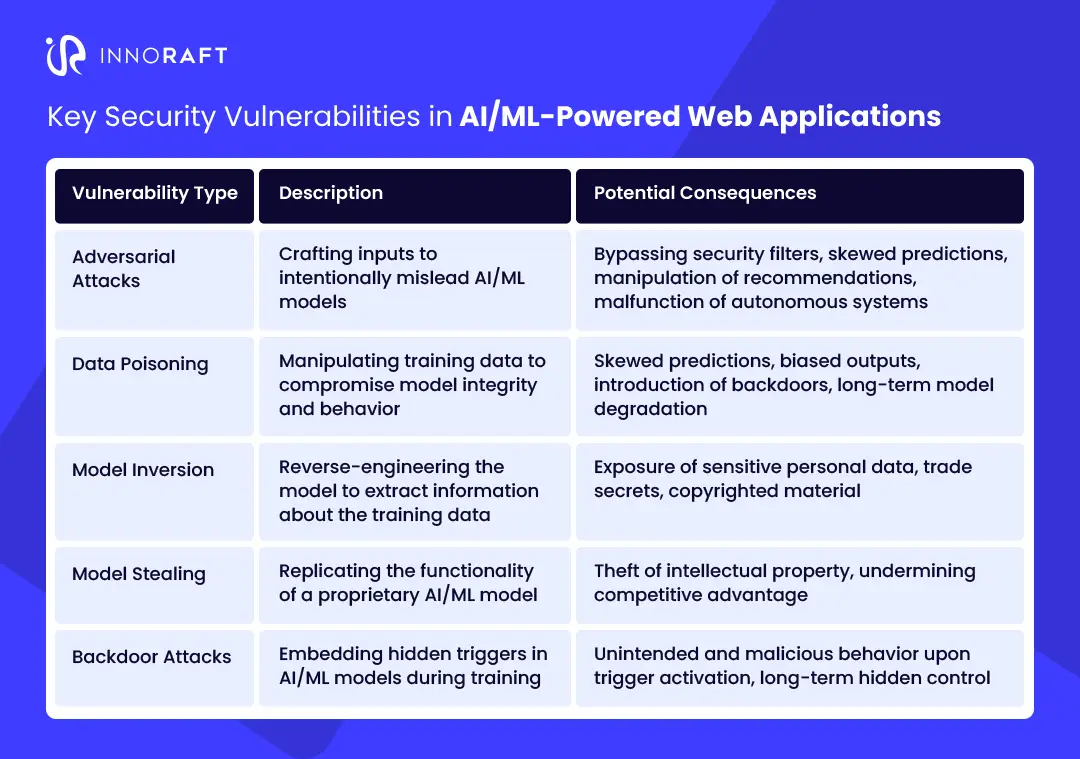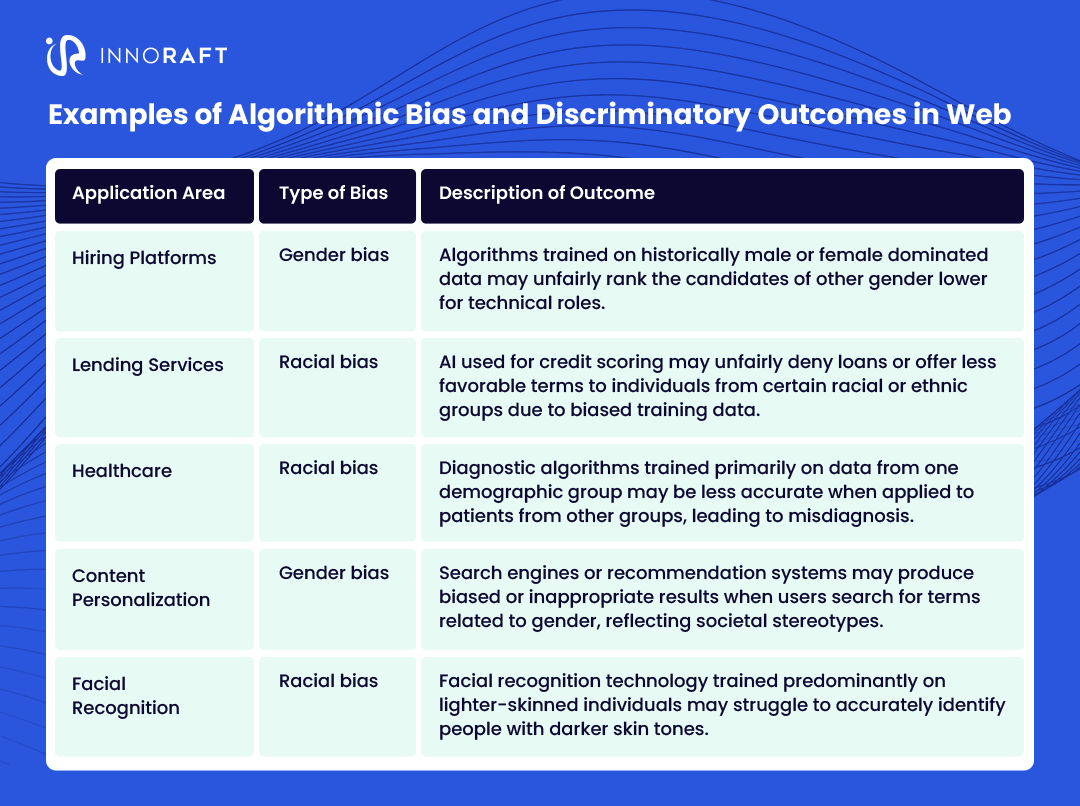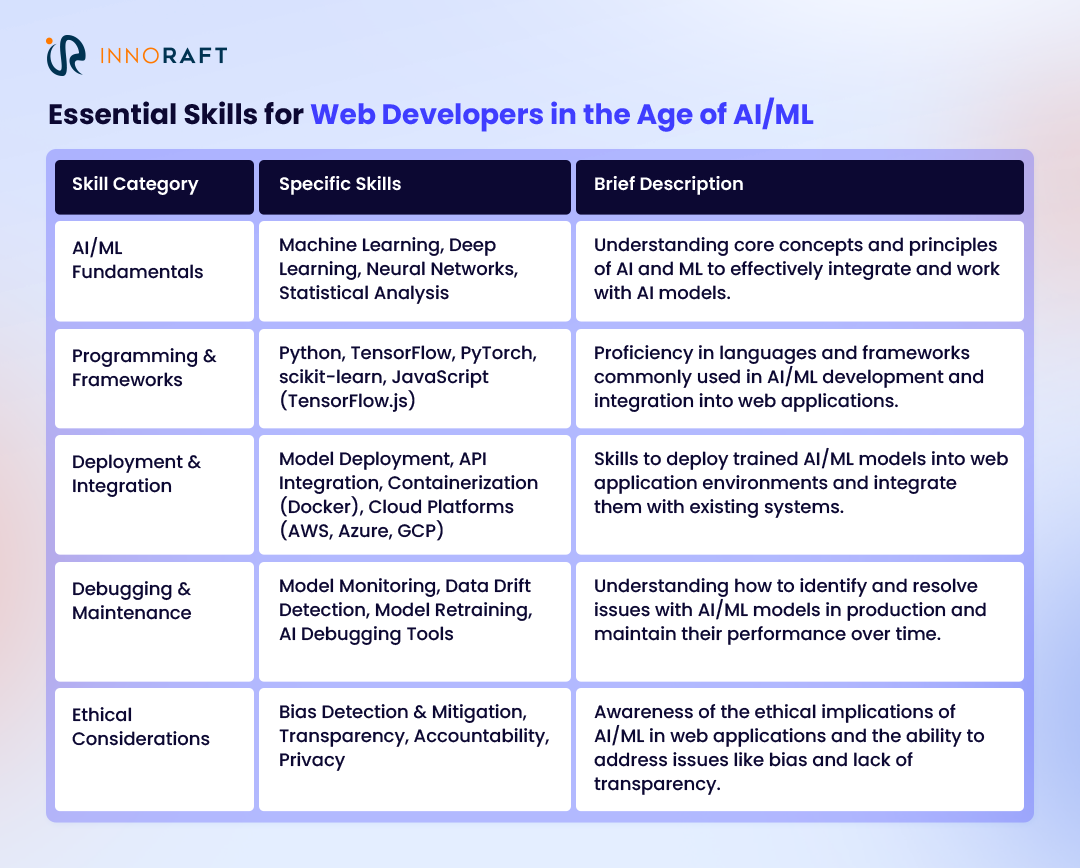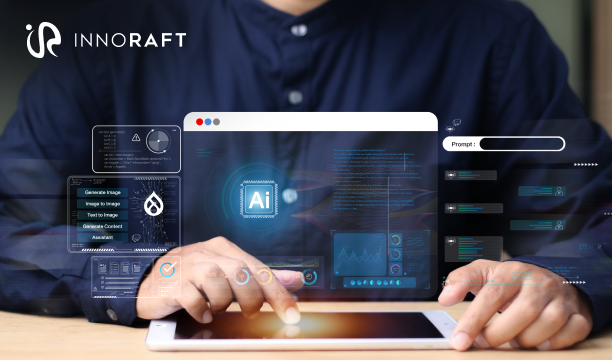Traditional web applications, characterized by their static nature, have now been replaced by more intelligent web apps. These modern web apps offer users a more personalized and highly interactive experience. This shift in web application development has been driven by AI/ML capability.
As users become accustomed to tailored experiences across various digital domains, the demand for smart web apps with AI continues to rise, accelerating the integration of AI and ML technologies.
From the tangible impact of AI and ML on web development to security and ethical implications, let's explore the growing role of AI and Machine Learning for web development. We'll take a deep dive into current applications, potential security risks, ethical considerations, changes in developer roles, deployment challenges, and the shifting user experience. We will also look ahead to the architectural changes and offer a comprehensive perspective on integrating these technologies responsibly and creatively.
AI and Machine Learning in Web Applications Development: Going Beyond Personalization
AI and ML have become integral to modern web application development, shaping how sites are built and how users experience them. Today, AI integration in web apps goes beyond basic personalization and spans multiple dimensions. Understanding all facets of AI/ML usage in web application development is essential to understand its impact and future applications.
Personalization & Recommendation Engines
For modern businesses, personalization is the key to excellent customer experience. With AI/ML, companies can offer greater personalization, analyzing user data, such as browsing history, purchase patterns, and preferences, to provide tailored experiences. You can create recommendation systems by leveraging techniques such as collaborative filtering, which identifies users with similar tastes, and content-based recommendations, which suggest items identical to those a user has previously engaged with.
Limitless personalization through AI-driven user experience has manifested itself in various ways across industries. Businesses leverage AI/ML algorithms to provide product and service recommendations based on individual preferences. AI/ML also helps companies implement dynamic pricing strategies, which help adjust prices based on real-time factors like demand, competitor pricing, and user behavior. Personalization has become a defining characteristic of modern web applications, contributing to increased user engagement, higher conversion rates, and improved customer satisfaction.
Chatbots & Virtual Assistants
Chatbots and virtual assistants are some of the standout features of AI-powered web solutions. Though chatbots have been around for a while, it is only in recent years they have evolved beyond simple rule-based interactions to sophisticated conversational agents that can learn from past interactions, understand the context of a conversation, and even exhibit a degree of emotional intelligence, leading to more natural and effective communication.
Modern chatbots and virtual assistants are intelligent systems that leverage the power of Natural Language Processing to understand and respond to user queries expressed in natural language. Chatbots are now one of the standard AI/ML-based web application features for providing round-the-clock customer support, answering FAQs, and guiding users through various processes.
Examples range from chatbots assisting with order tracking and product information to more sophisticated virtual assistants handling complex inquiries and event-automating tasks. The benefits of deploying chatbots include round-the-clock availability, which enhances user conveniences, reduces operational costs for businesses by automating routine interactions, and improves user engagement through immediate and personalized responses.
AI-Assisted Design & Development
Besides influencing user experience and reshaping the customer service processes on web application development, AI and ML strongly impact the development and design process. In recent years, various AI-powered design and development tools have emerged that can automate various stages of the development lifecycle, enhancing efficiency and freeing developers to focus on more strategic and creative tasks. For instance, tools like WIX ADI (Artificial Design Intelligence) can automate the website layout creation process based on the user requirements, saving time and effort in the initial design phase.
AI and Machine Learning algorithms for websites are also used for code optimization and debugging, with tools like DeepCode, GitHub, and Copilot assisting developers in developing, identifying, and fixing bugs, suggesting improvements, and ensuring smoother operation of web applications. The ability of AI to automate repetitive tasks, such as testing and quality assurance, also contributes to faster development cycles and improved code quality. Additionally, AI is being leveraged for content generation and curation, assisting in creating product descriptions, articles, and other website content. These applications highlight how AI is transitioning from a mere feature within web applications to a valuable assistant in their creation and maintenance, leading to increased productivity and a greater focus on innovation.
Along with these core applications, AI and Machine Learning in web applications are also being used for various other features, such as voice search optimization, image recognition, and, last but not least, enhancing web application security. AI and ML algorithms can improve fraud detection, identify unusual patterns, and predict potential security breaches. Moreover, predictive analytics, driven by AI/Machine Learning algorithms for websites, enables web applications to anticipate user behavior and optimize server load management, ensuring a more seamless and efficient user experience. The breadth and depth of these applications underscores the transformative potential of AI and ML to shape the future of web development.
AI/ML is transforming web development far beyond personalization. From intelligent interfaces to autonomous design tools, these technologies enhance how websites are built and how users experience them. However, as capabilities grow, so does the need for ethical design—ensuring these tools serve users, not subtly manipulate them.
Shadows in the Machine: Unpacking Overlooked AI/ML Security Vulnerabilities
While AI and Machine Learning for web development bring powerful capabilities to web applications, they also introduce new and often overlooked security risks. Unlike traditional threats, these vulnerabilities stem from the inner workings of the models themselves, demanding a fresh approach to security.
Adversarial Attacks
One of the primary concerns is adversarial attacks—malicious inputs crafted to trick AI/Machine Learning algorithms for websites into making incorrect decisions. Often indistinguishable from normal data, these inputs can bypass security filters, manipulate outputs, or even cause critical system failures. A growing threat in web apps using large language models (LLMs) is prompt injection, where attackers manipulate model behavior to leak sensitive data or generate harmful content.
Data Poisoning
Data poisoning attacks target the training process itself. By inserting malicious data into training sets, attackers can subtly distort a model’s behavior—causing spam filters to misfire, recommendation engines to favor specific content, or even embedding hidden backdoors. These attacks are hard to detect and can degrade performance or introduce long-lasting, malicious effects.

Model Inversion & Stealing
Attackers can also exploit trained models through model inversion—reverse-engineering outputs to extract sensitive information from the training data—or model stealing, where repeated queries help reconstruct and clone proprietary models. Both methods threaten privacy and intellectual property, emphasizing the need for protections like access controls, differential privacy, and model hardening.
Backdoor Attacks
Backdoor attacks can be especially insidious. By embedding hidden triggers during training, adversaries can ensure the model behaves normally—until a specific input activates malicious behavior. These attacks are difficult to detect and have severe consequences, especially in high-stakes environments like healthcare or autonomous systems.
The Moral Compass: The Ethical Considerations in AI-powered Web Solutions
Integrating Artificial Intelligence and machine learning into web applications introduces many ethical challenges. Unlike rule-based systems, AI/ML models often operate with complex, opaque logic, making ethical issues harder to detect and address. With millions of users relying on these tools, even minor lapses in AI design and deployment can have wide-reaching societal impacts.
A significant concern of AI integration in web apps is algorithmic bias, which can lead to discriminatory outcomes. Bias may stem from flawed training data, underrepresented groups, or the measurement of certain features. In real-world applications, this can result in job platforms ranking candidates unfairly, lending tools denying loans to specific demographics, or healthcare apps misdiagnosing patients. Even content personalization can reinforce harmful stereotypes by limiting exposure to diverse perspectives. Because AI can amplify existing inequalities, tackling bias requires continuous effort through better data, careful model design, and regular auditing.

Transparency is another key issue. Many AI models, especially deep learning systems, function as black boxes, making it difficult to understand or explain their decisions. This lack of clarity undermines accountability and can erode user trust, particularly for AI-powered web solutions making high-stakes decisions. The emerging field of explainable AI (XAI) addresses this gap, aiming to make AI systems more interpretable and trustworthy.
Finally, there's the matter of user autonomy and manipulation. AI-driven personalization, while convenient, can cross ethical lines when it subtly influences user behavior, especially in advertising or content delivery. Over-personalization risks creating filter bubbles that limit users' perspectives. Designers must be mindful of how these systems shape user experiences and ensure transparency, consent, and control remain central.
Ethical AI integration in web apps isn't just a technical challenge- it's a human one. Responsible development means building fair, transparent systems that respect user autonomy.
Navigating Deployment and Scaling Complexities
Deploying AI/ML models in web applications presents distinct challenges. Integration isn't always straightforward—it demands careful planning around platform compatibility, operating environments, and efficient data pipelines to keep predictions flowing in and out of the app smoothly. Managing model versions and updates adds another layer to the mix, making architectural design crucial for reliability.
Latency is another significant concern. Complex Machine Learning algorithms for websites may offer better accuracy but often slow response times. Developers must strike a balance, using techniques like model optimization, quantization, or edge deployment to keep things fast and responsive—key to a good user experience.
AI/ML workloads are resource-heavy, especially under variable user demand. Efficient resource management—balancing CPU, GPU, and memory—is critical. Scalable architectures, particularly cloud or serverless setups, help meet demand without overprovisioning or driving up costs.
Finally, model performance can degrade over time due to shifting data patterns—a phenomenon known as model drift. Continuous monitoring is essential to catch these shifts early. Automated tools can flag issues, prompting timely retraining to keep models accurate and relevant.
Evolving Role of Web Developers
AI and machine learning are reshaping web development—not by replacing developers but by enhancing their capabilities. As AI-powered web solutions leverage automated routine coding tasks, developers are shifting focus toward complex problem-solving and strategic thinking. They must embrace new tools, technologies, and working methods to stay relevant.
A strong foundation in AI/ML concepts—like Machine Learning algorithms for websites, neural networks, and deep learning—is becoming essential. Developers should be familiar with Python and frameworks such as TensorFlow, PyTorch, and scikit-learn. For projects involving natural language, knowledge of NLP techniques is increasingly valuable. As web applications grow more data-driven, data handling, visualization, and AI model deployment skills are also in high demand. The line between web developer and data scientist is blurring, making versatility key.

AI integration in web apps also brings new challenges, especially debugging and maintenance. Unlike traditional bugs, AI issues often stem from data quality, model drift, or changing input patterns. Developers must monitor performance, retrain models, and interpret complex system behavior—requiring a data-focused mindset and familiarity with evaluation metrics. Fortunately, new tools are emerging to support this evolving aspect of development.
Collaboration between web developers and AI/ML specialists is critical. Developers offer expertise in building seamless, scalable applications, while data scientists bring deep knowledge of model training and optimization. When these roles work in sync, they can create intelligent, user-focused applications that are both powerful and maintainable.
The growing integration of AI and machine learning is set to transform how web applications are built and evolve. Web architectures will likely shift toward more modular, service-oriented designs to support intelligent ML-based web application features, enabling AI components to be developed, deployed, and scaled independently. AI's heavy computational needs will also drive greater reliance on cloud platforms that offer scalable infrastructure and specialized hardware.
This shift may inspire new architectural patterns tailored for AI, focusing on efficient data flow, model lifecycle management, and flexibility for rapid innovation.
The use of AI and ML for web application performance enhancement will also disrupt traditional development workflows. Low-code and no-code platforms—many powered by AI—are lowering the barrier to entry, empowering non-developers to build applications. At the same time, AI is automating tasks like coding, testing, and deployment, pushing developers to focus more on system design, user experience, and ethical implementation.
Looking ahead, we can expect more advanced AI agents embedded in web apps, capable of making decisions and interacting with users intelligently. When combined with emerging tech like Web3 and XR, AI may create new immersive, decentralized, and personalized web experiences. Ultimately, AI/ML will reshape the internet as we know it, driving faster innovation and smarter digital interactions.
Conclusion: Embracing Responsible Innovation in the Age of Intelligent Web Applications
The growing influence of AI and machine learning is reshaping how we build and think about web applications. As smart web apps with AI become standard, web architecture is shifting toward modular, service-based designs that support independent development and scaling of AI components. This change also drives increased reliance on cloud platforms to meet the heavy computing demands of AI models.
We’ll likely see entirely new AI analytics and architectural patterns emerge—ones built to manage AI workflows, data pipelines, and model lifecycles more efficiently. Meanwhile, traditional development practices are being disrupted. AI-powered low-code and no-code platforms allow more people to build web applications, while automation streamlines coding, testing, and deployment.
For developers, this means evolving roles: less time on routine tasks and more focus on system design, AI-driven user experience, and ethical AI use. As AI capabilities grow, so will expectations for creativity and strategic thinking.
Looking ahead, intelligent agents and autonomous systems will become more prominent in web applications, enabling smarter, more interactive user experiences. When combined with emerging tech like Web3 and XR, AI/ML could power entirely new digital experiences—some of which we can’t yet imagine.
The future of the web is intelligent, adaptive, and deeply shaped by AI. The challenge—and opportunity—lies in embracing that future responsibly.
FAQ
Frequently Asked Questions
AI is used across many industries to enhance web applications in practical ways:
- E-commerce: AI powers dynamic pricing, personalized product recommendations, and smart search features based on user behavior and trends.
- Healthcare: Web portals use AI to help patients book appointments, get symptom checks through chatbots, and access personalized health insights.
- Finance: AI helps detect fraudulent activity, automate customer support, and provide tailored financial advice through robo-advisors.
- Media & Publishing: Content platforms use AI to curate news feeds, suggest relevant articles, and even automate headline generation.
- Education: Online learning platforms use AI to recommend learning paths, assess student performance, and deliver personalized feedback.
- Travel & Hospitality: AI assists with trip planning, dynamic booking systems, and personalized travel suggestions based on user preferences.
Each of these examples shows how AI is embedded into web apps not just to "wow" users—but to make experiences faster, smarter, and more relevant.
Didn’t find what you were looking for here?

